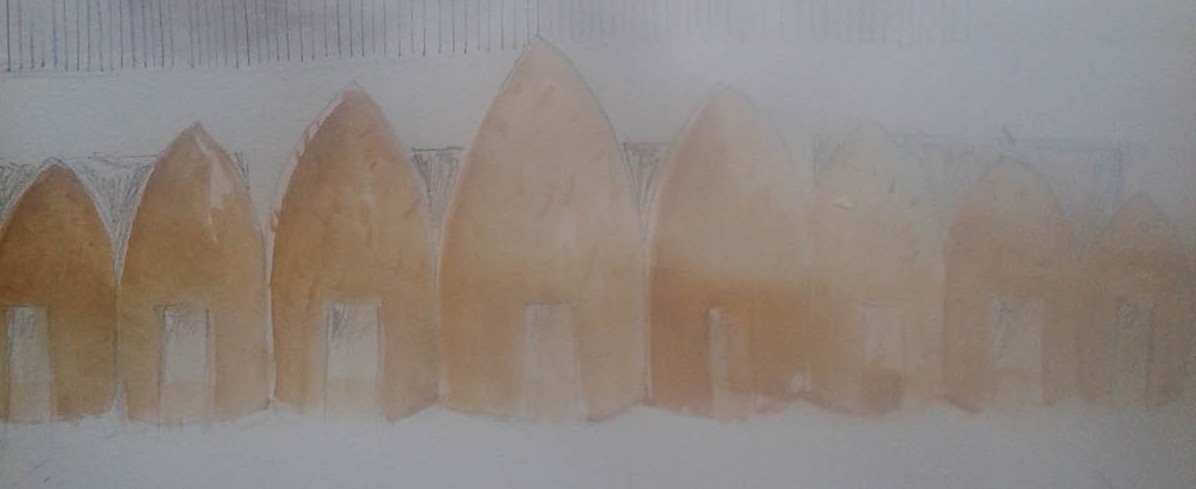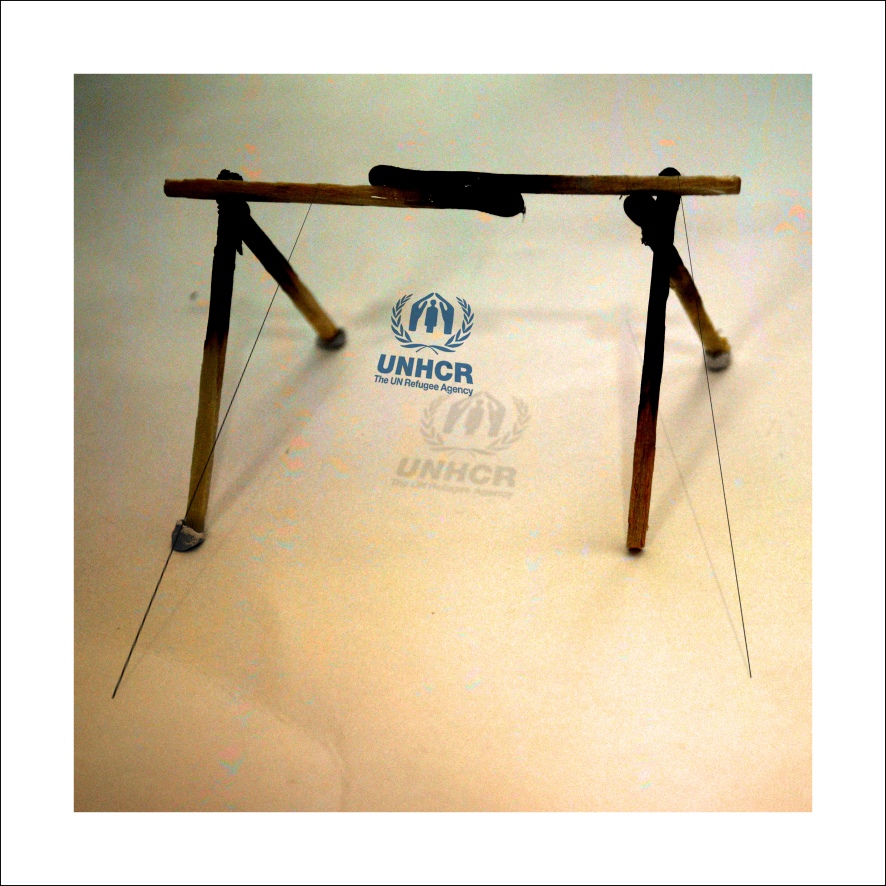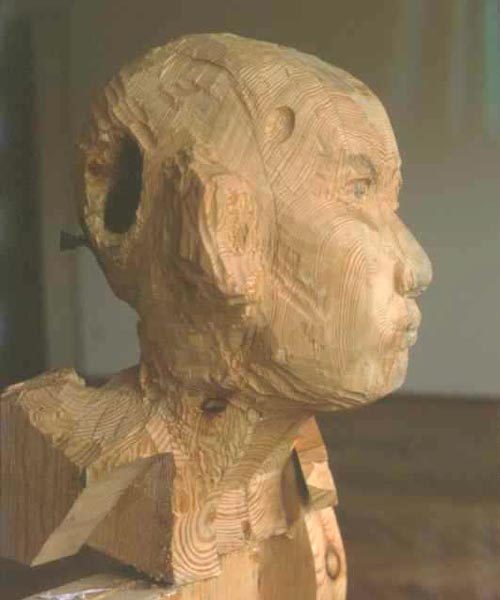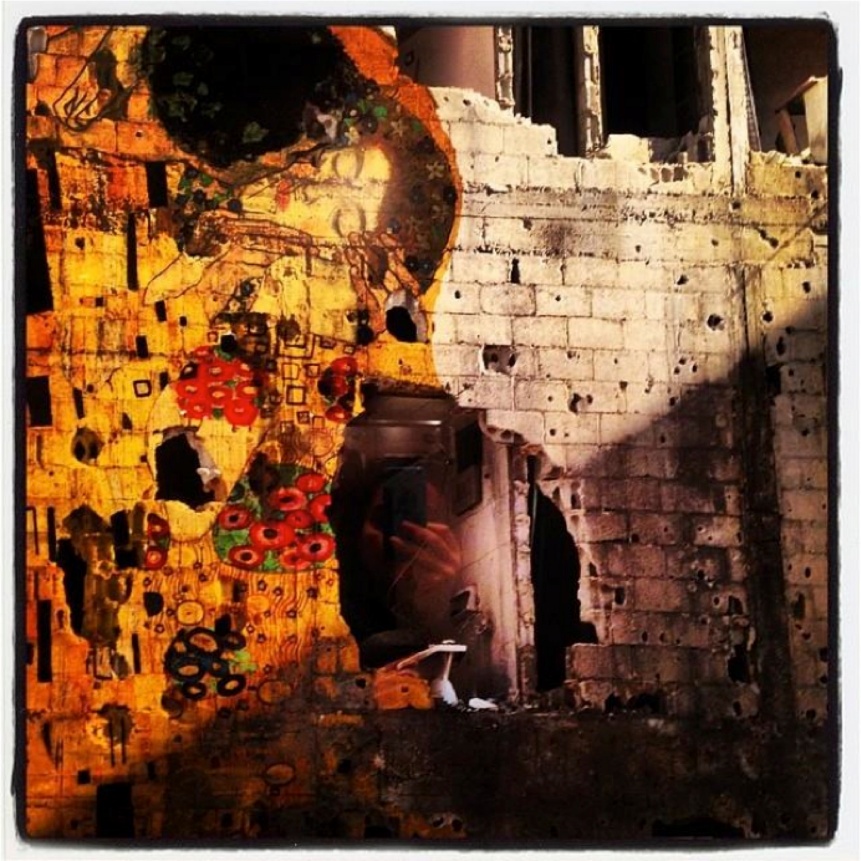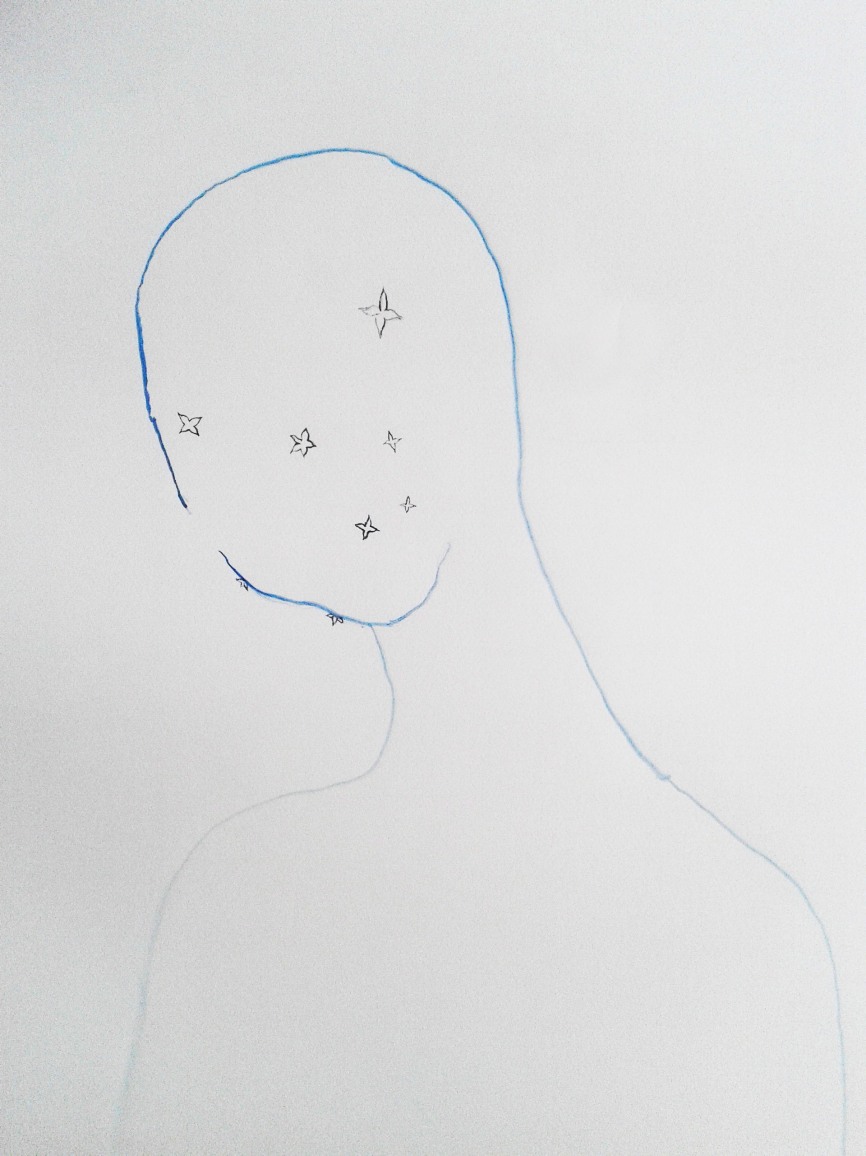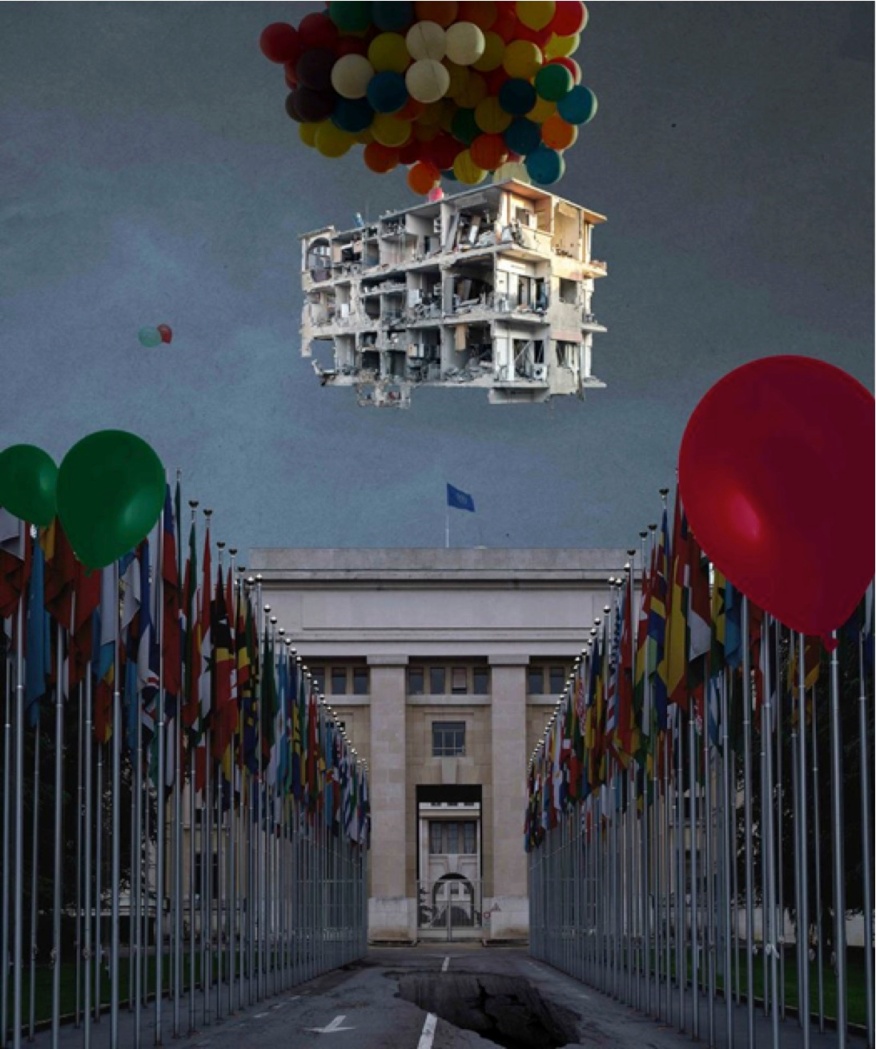Syrian Voices in Budapest On the Work of Tammam Azzam in Budapest exhibition at Lena and Roselli Gallery , Galamb utca 10, Budapest opening 2014 May 15th open until 2014 June 14 A recent work by Tammam Azzam caught my attention: it is a tent. Its simplicity is intellectually refined, allowing it to incite empathy in the viewer: the artist has leaned some matches against each other in such a way that they create a tent. A minimal symbol of the refugee tent: triangles and the logo of the UN. While the tent signifies a situation, it does not offer any protection, home or shelter. The matches create a strong sign, revealing the inner awareness of the artist. In each moment, even when only playing with some matches, his soul is with those who suffer. Whether it is merely a piece of paper, crumbs of bread, or wooden matches, all that he touches takes on – perhaps even unconsciously – the shape of projections of thinking – and his mind (or consciousness) is always with those who suffer and are forced to flee. Each moment is precious.
Tammam Azzam, Camp, 2014 Syrian lifestyle always possesses something that is simple, modest and elegant. Daily life and the beauty of objects was always so unaffected, so close to human nature, so unpretentious. There was an enormous rift between the rigid pathos of the official state-supported art and the simple aesthetics of daily life. This rift has almost completely disappeared with the revolution. The artists who led the nonviolent movement in 2011 addressed the people in a direct immediate and informal way with their urgent message. Their style was often expressive, hoping and trusting that the world would help us get rid of forty years of horrible repression. Now in 2014, after three years of revolution and war, the work of many artists no longer shows an expressive dynamism, but rather a deep contemplation on loss and the feeling of personal incapacity. Artists sob and mourn together with all Syrians; yet, even in this moment of sadness, their works present something immediate, unaffected, and a beauty of wise serenity and brightness. Its source is enigmatic. I have discovered all these qualities in the works of Tammam Azzam. The refugee tent he has formed just with matches is simple, intellectual and full of empathy. Another motif that I see again and again in Syrian art and activism is the balloon – a colourful balloon. I even used this element in one of my early works from 1999: a female figure covered in black, holding an orange balloon tightly in her lap (R. thinking/dreaming about overpopulation, 1999). In another sculptural work of mine, Le Voyante (The Seer/2 , 2000 ), a black balloon fills the space behind the face, in a daydream, a dream/nightmare, and a vision of those who see. The balloon is etherealised, unworldly, but without pathos (or power representation), since it costs only a few Hungarian forints or Syrian lira.
Le Voyant, Róza El-Hassan, 2000, wood and ballon, collection Ropach, photo R.E-H. Collection Thaddeus Ropac
In Diala Brisly’s children’s book illustration, a little boy steps out of the space and towards the reader, holding a balloon in one hand, and smiling – but one of his small legs is only a stump in a bandage. The small child limps toward the reader on crutches. In Fadi Zyada’s digital painting, children fly from the ruined street of a shelled city toward the celestial sky, red balloons in their hands and Banksy’s balloons, who is not Syrian, but who supported Syria and Palestine through his grafitties. Syrian artists do not serve any kind of overloaded ideology. There are generally no inherent symbols of ideology or religion in their images. Spirituality and believe is present in the light, and color but not in dogma, there is no war of symbols. Syrian artists build our ethereal citadels of everyday objects – and these etherealised, airy citadels are our only possibility for survival. In many of the works of Tammam Azzam, we can see a shelled house, a ruin enhanced with a line of balloons flying in the sky. Is this the sadness of a lost home? The symbol of Syria? A ruin, rising above the UN headquarters in Geneva. The ruin is a symbol of ruin and death, a wreck – ballooned, flying and rising. The image is enigmatic, thick with secrets: is it our confidence, our trust in the future, that is rising, despite all the grief, into the heights? Or is it our hope, which can only fly – drift – away, after the second Geneva conference on Syria? Beyond its local meaning, Syrian art demonstrates the necessity of social change, and its human face. These works are close to so many people: they are contemporary, but they still speak an accessible language of art. They do not use pathetic, ideological or dogmatic elements, or any symbols of religion or ideology, which would carry burdens of the past. Recurrent motifs in the work of young Syrian artists include balloons, matches, the small white jasmine flowers of Damascus, the chair (the throne of the dictator or power), the donkey (simp), which in my childhood was a euphemism for the President’s name – when to even mention his name was a real danger , and folded newspapers and magazines: the symbol of dead-ended, wrecked politics. Further motifs include caricatures from newspapers, cartoons and cheap postcards, reproductions of famous paintings of world history; they are also affordable objects from daily life. The little red heart from the tarot card is not a symbol of personal love, but stands for all mothers who ever bought a paper heart for their little one. The revolution does not promote something that is wild and scary: the people ask for the possibility of an average, modest but happy life. This request was punished by the Syrian Assad regime with the death of hundreds of thousands. Three years later, artists continue to create images – one year on, some had decided to fight – and the bloggers continue blogging. They create new images day in day out, full of serenity in their deepness, simplicity and intellectuality. Tammam Azzam is an outstanding artist on this Syrian art scene. His works have been shown in Berlin, New York, many places worldwide. Reproductions of his works have appeared in the New York Times and all major magazines. One of his widely shown works is his revival of the world-famous historical painting: the motif of Gustav Klimt, famous figure of the Viennese movement of Secession, which came into being more than a century ago. Azzam revitalises the original image of iconic strength from its dusty existence on postcards and reproductions, creating a new icon: the icon of love, freedom and death in the 21st century. These images are not made for the art market. Their genuine intention is to give strength to the Syrian comrades and citizens, to the millions of desperate Syrians, who are still not broken, but motivated by three years of horrific repression by the regime, which we cannot even imagine. Tammam Azzam, alongside other Syrian artists, actors and musicians, contributes to this inner mental strength. Their images and their relation to the world – history and civilisation – support not only Syrians, but help all of us, each individual, to survive mentally the worldwide crisis – and the crisis of our civilisation cannot be denied. Tammam Azzam will show his work in Budapest, for the first time together with me, on the generous invitation of Dr. Ilona Orosz, in the Lena & Rosselli Gallery. While we both travel and exhibit our work quite a lot, representing Syria art internationally, we have never met until now. I myself also represent Hungarian art, in a kind of hybrid culture, as the child of a Hungarian mother and Syrian father. In any case, it is not important if we are famous or unknown, old or young, man or woman, child or adult, rich or poor: we should all be ultimately modest and humble. The only possible attitude is humility, when our airy artistic citadel is build on the all too real and horrible sacrifice of the Syrian people. R. El-Hassan 2014 for Syrian Voices, all right with the author and Syrian Voices Syrian Voices is founded by Shadi Alshhadeh and Roza El-Hassan in 2012 January. it is an open platform for art and social discourse Post script: On Syria Syria is a country on the Arabian Peninsula, at the Euphrates River and Mediterranean coast. The region is also known as the Cradle of Civilisation, since it is incredibly rich in cultural historical heritage. Over the course of history, it has hosted cultures of Mesopotamian, Roman, Hellenistic origins, and it is rich in Christian monuments, with a large Christian minority among its population. In its beginnings, prior to the earliest Middle Ages, Islamic science synthesised the Hellenistic, Roman and Mesopotamian, Arab nomadic and Byzantine elements. I would even dare to state that since 2011, we have lived, in the field of Syrian revolution and culture, a new era that synthesises the Renaissance and humanism, with the strength to fuse diverse cultural, ideological elements.
Tammam Azzam, Freedom Grafitti 2013
Roza El-Hassan, Yasmeen Head, 2014
Tammam Azzam, Geneve, 2014
